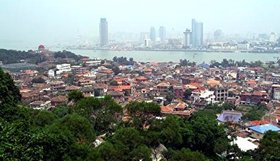Xiamen
|
|
Xiamen (Template:Zh-stpw) is a coastal sub-provincial city in Fujian Province, southern China.
- Language: Local dialect is Hokkien (or Min Nan, or Taiwanese). Mandarin, the official standardized dialect, is also used here
- Area: 1565.09 km² (300 km² water)
- Population: 1,371,600 (late 2002)
- GDP per capita: ¥38567 (ca. US$4660) in 2003, ranked no 9 among 659 Chinese cities.
Xiamen is also known as Amoy internationally, which is how "Xiamen" is spoken in Northern Min, the vernacular of the provincial capital Fuzhou. In the vernacular of Xiamen, known as Southern Min, it is pronounced Ē-mn̂g. The placename means "The Gate of the Grand Mansion".
Xiamenchina.jpg
| Contents |
History
Xiamenchina2.jpg
The place was made Tong'an District (同安縣) in 282, a sub-entity of Jin'an Prefecture (晉安郡). In 1387, the Ming Empire used it as base against pirates, and was part of Quanzhou. Koxinga stationed here in 1650, naming it Siming Island (思明洲), or "Remembering the Ming", but the city was renamed by the Manchus in 1680 to Xiamen Subprefecture. The name "Siming" was reverted after the 1912 Xinhai Revolution and made a county. The following it was reverted to Xiamen City. In 1949, Xiamen became a provincial city (省轄市), then upgraded to a vice-province-class city (副省級市), or a municipality. It was made a Special Economic Zone in 1980.
Xiamen was the port of trade first used by Europeans in 1541. It was China's main port in the 19th century for exporting tea. As a result, the Amoy dialect had a major influence on how Chinese terminology was translated into English and other European languages. For example, the words "Amoy", "tea" (茶), "cumshaw" (感謝), "ketchup" (茄汁), "satay", and "Pekoe" (白毫) originated from the Amoy dialect.
Xiamen was one of the five Chinese treaty ports opened by the Treaty of Nanjing (signed in 1842) at the end of the First Opium War between Britain and China.
In 2000, the largest corruption scandal in China's history was uncovered, implicating up to 200 government officials.
Administration
All six sub-municipal entities in Xiamen are districts, whereas other Fujianese municipalities have mixed districts and counties.
- Haicang District (海沧区)
- Huli District (湖里区)
- Jimei District (集美区)
- Siming District (思明区)
- Tong'an District (同安区)
- Xiang'an District (翔安区)
Siming and Huli co-exist with the Special Economic Zone.
In May 2003, Gulangyu and Kaiyuan were merged into Siming. Xinglin District (杏林區) was renamed Haicang District. Xiang'an was created out of a section of Tong'an.
Geography

Xiamen Municipality comprises of Xiamen Island, Gulangyu Island, and a larger region along the mouth of Jiulong River on the mainland. Huli District and most of Siming District (except Gulangyu) are on Xiamen Island. The other four districts are on mainland.
Xiamen Island is geographically very close to the island of Quemoy, which is governed by the Republic of China (based on Taiwan).
Transportation
Xiamen is served by the Xiamen Gaoqi International Airport, which is the base of Xiamen Airlines.
A ferry links Xiamen Island and Gulangyu Island.
Colleges and Universities
National:
- Xiamen University (厦门大学) (founded in 1921) (shortform "Xiada")
Public:
- Lujiang University (厦门理工学院/鹭江职业大学)
- Jimei University (集美大学)
- Xiamen Oceanography Vocational College (厦门海洋职业技术学院)
Private:
- Xiamen Nanyang College (厦门南洋学院)
- Xiamen Yanyi College (厦门演艺职业学院)
- Informatics College (Xiamen) 英华美(厦门)学院
Miscellaneous
Xiamen is twinned with:
- Cardiff, Wales (since 1983)
- Sasebo, Japan (since 1983)
- Cebu, Philippines (since 1984)
- Baltimore, Maryland, United States (since 1985)
- Wellington, New Zealand (since 1987)
- Penang, Malaysia (since 1991)
External links
- Expatriates Guide to Xiamen and Fujian Province (http://www.amoymagic.com)
- City guide to Xiamen, updated frequently (http://www.whatsonxiamen.com)
- Official website (http://www.xm.gov.cn/) (in English, Simplified Chinese, and Traditional Chinese)
Template:Fujiancs:Sia-men da:Xiamen de:Xiamen es:Xiamen fr:Xiamen gl:Xiamen - 厦门 zh-min-nan:Ē-mn̂g ja:アモイ sv:Xiamen zh:厦门
